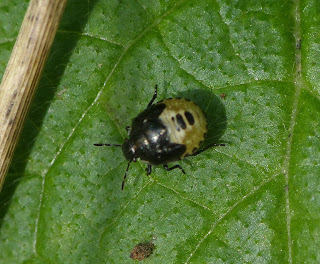On the face of it a site named after a road in a large industrial estate in Telford has little going for it. And looking at the map does not whet the appetite. A patch of land sandwiched between industrial units and the railway line that runs down to the power station.
However, a small party from the moth group visited the site last year and recommended it as a place to visit. So, always welcoming recommendations, we descended on the site.
The first issue was - where to park? Halesfield 24 and the equally unimaginatively named Halesfield 21, which are closest the site, are busy thoroughfares that abound with large vehicles - not ideal places to park.
A suitable spot was found in a residential area on the other side of the railway and Eastern Primary (which runs parallel to the railway at that point) to the south west of Holmer Lake. (There is a car park on the north side of the lake which would have been a better place to park - but did involve a longer walk to the site.)
No matter, suited and booted we set off for the site.
First impressions were not good as the path we were taking descended and went through a gloomy underpass under the Eastern Primary. Its walls, of course, were covered in graffiti but for once, in amongst the drawings and words of crudeness there were some attempts to be humorous and artistic including a fine painting of a peregrine's head.
No sooner had we emerged into the light than we went under a second underpass to cross the railway. The path then took us through some woodland before opening out onto mown grassland. The grassland was surrounded by trees and a reasonable buffer of rough grassland.
We did not stay here but made our way to a wildflower meadow. As it was late in the year it had been cut, so we were unable to appreciate this area.
Like the first grassland this area was surrounded by trees and rough grassland. In addition there was a circular path worn, not by walkers doing laps of the site, but by bikers. When we arrived there were a couple revving up but, thankfully, they soon left.
We set to work looking, beating, sweeping and vaccing.
A beat of bramble disturbed an aggregation of 16-spot ladybirds. There were more than thirty in the corner of the tray with some bramble leaves. They soon dispersed. Here are a couple who posed for a photograph together with a money spider.
 |
| Photograph: David Williams |
 |
| Photograph: David Williams |
I wandered around the edge of the site beating the odd tree, oak, alder, scot's pine and grey poplar to see what I could find. The Grey poplar came up trumps by hosting the planthopper Viridicerus ustulatus. This a recent arrival to these shores and its first record in the county. Sorry, no photograph but you can see it on the British Bugs website here.
The bramble around the edge of the meadow was the main nectar source and attracted insects to feed including this Eristalis tenax.
 |
| Photograph: Jim Cresswell |
 |
| Photograph: David Williams |
Stars of the show were long-winged coneheads.
 |
| Photograph: David Williams |
A spider Araneus quadratus was photographed on her web
 |
| Photograph: David Williams |
 |
| Photograph: David Williams |
An alder tree yielded the large colourful mirid bug Pantilius tunicatus.
 |
| Photograph: Jim Cresswell |
 |
| Photograph: David Williams |
No shieldbugs?
Were'n't there any?
Of course there were.
Here are a few of what we saw.
 |
| Spiked shieldbugs - Photograph: Jim Cresswell |
 |
| Dock bugs - Photograph: Jim Cresswell |
 |
| Hairy (or Sloe) shieldbugs - Photograph: Jim Cresswell |
The main grassland areas of the site were really of no interest as the grass had been cut but the transition areas between the grass and the trees and the uncut rough grasslands proved to be very productive and provided some unexpected finds. The site turned out to be far better than I had anticipated.
My thanks to the Shropshire Moth Group for suggesting the site, Telford and Wrekin Council for permission to do what we enjoy doing and to Jim Cresswell and David Williams for their excellent photographs.































































